My wife has recuperated from her appendectomy – for the most part – she’s still in the recliner by evening, taking it easy. Her middle-school opening got delayed for a week, but she had to go into school this morning to do set up. She’s not having any students today – they start tomorrow, and knowing the history of Connie catching everything sick students bring into school… well… if I sit and think about it, I’m quite likely terrified at a situation that seems dangerous and completely out of my control. I’m not sure if playing complicated and immersive video games is “handling the situation very well,” but it sure keeps my mind off it…

Saturn and Jupiter appear in the southern sky after sunset near the constellation Sagittarius, and are visible for several hours into the early morning.
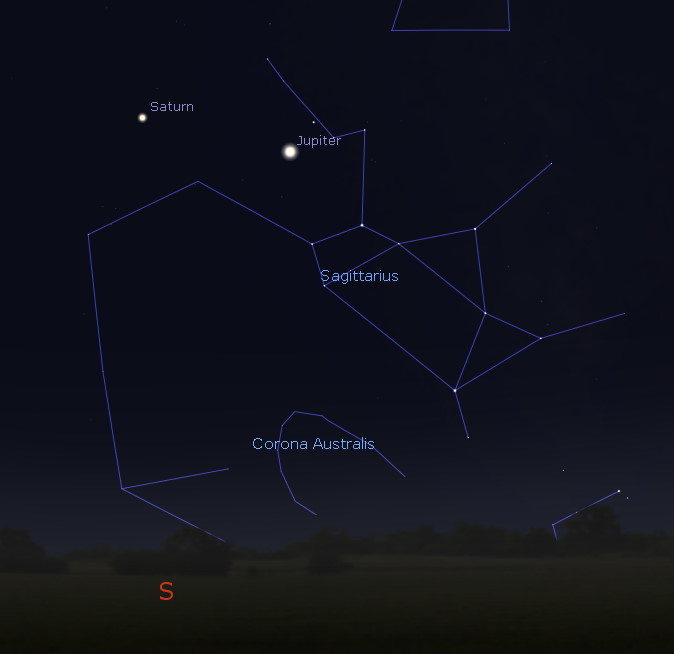 Saturn and Jupiter appear in the southern sky at 10:00 pm this week. Credit: Stellarium / Bob Trembley.
Saturn and Jupiter appear in the southern sky at 10:00 pm this week. Credit: Stellarium / Bob Trembley.Mars appears in the east-southeastern sky at 3:00 AM this week – the Moon appears in the eastern sky with Mars on Sept. 9th.
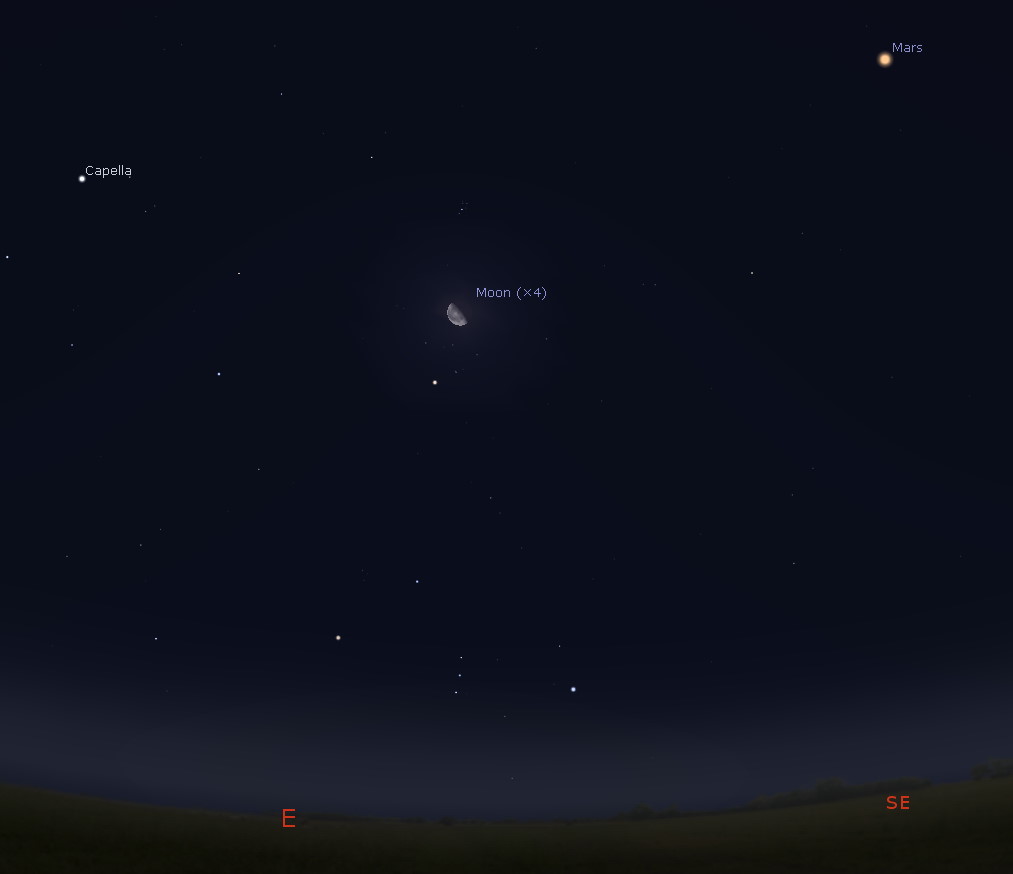 Mars and the Moon appear high in the east-southeastern sky at 3:00 AM on Sept. 9th. Credit: Stellarium / Bob Trembley.
Mars and the Moon appear high in the east-southeastern sky at 3:00 AM on Sept. 9th. Credit: Stellarium / Bob Trembley.Venus and the constellation Orion appear in the east-southeastern predawn sky on Sept. 9nd.
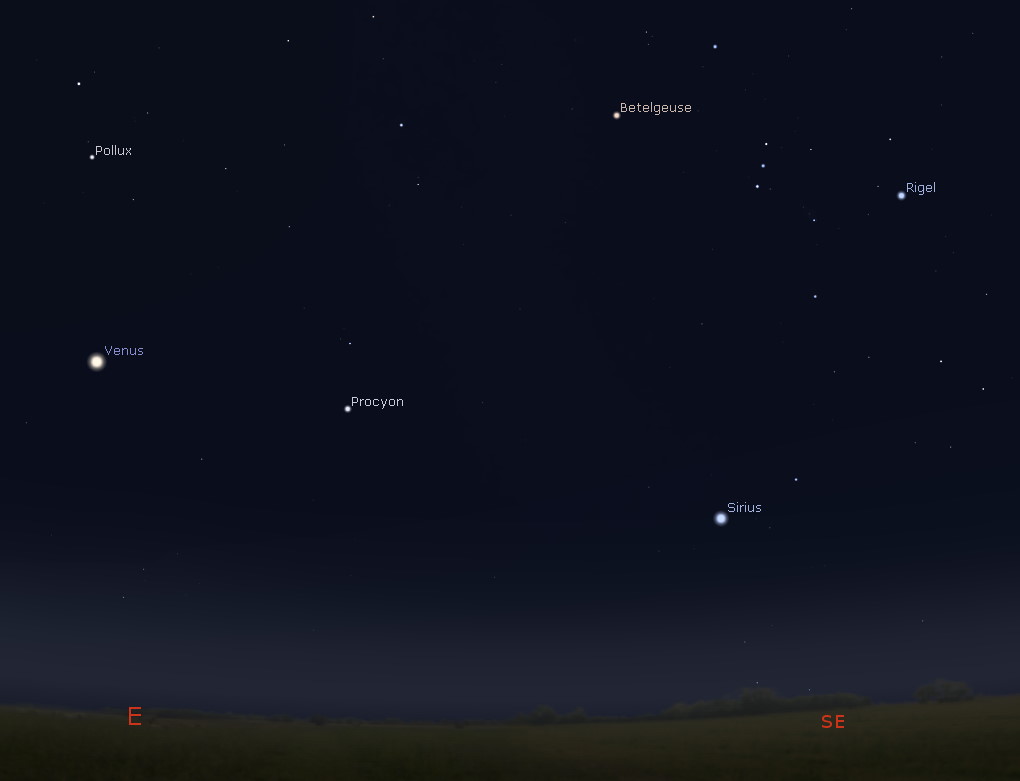 Venus and and the constellation Orion appear in the eastern predawn sky on Sept. 9th. Credit: Stellarium / Bob Trembley.
Venus and and the constellation Orion appear in the eastern predawn sky on Sept. 9th. Credit: Stellarium / Bob Trembley.The Moon appears in the Eastern predawn sky with Venus from Sept. 11-14th, appearing VERY near Venus on Sept. 13th.
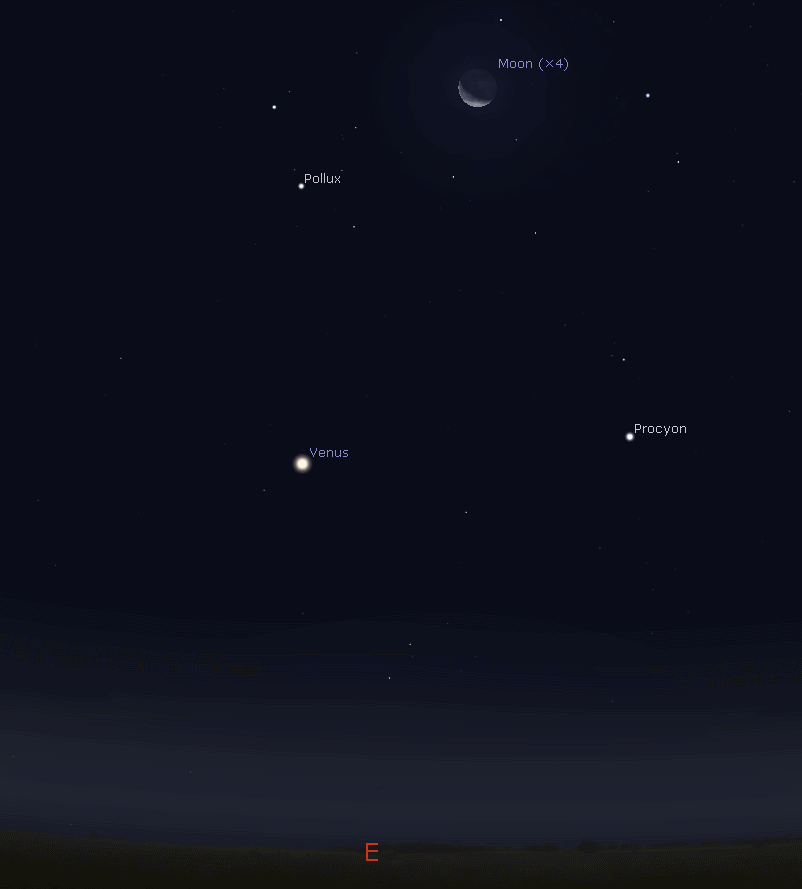 The Moon appears in the Eastern predawn sky with Venus from Sept. 11-14th. Credit: Stellarium / Bob Trembley.
The Moon appears in the Eastern predawn sky with Venus from Sept. 11-14th. Credit: Stellarium / Bob Trembley.
The Moon is a waning gibbous, rising after sunset, visible high in the sky after midnight, and visible to the southwest after sunrise.
The third quarter Moon occurs on Sept. 10th, rising around midnight, and visible to the south after sunrise.
After Sept. 10th, the Moon will be a waning crescent, visible low to the east before sunrise.
 The Moon from 2020-09-08 – 2020-09-14. Visualizations by Ernie Wright / NASA’s Scientific Visualization Studio.
The Moon from 2020-09-08 – 2020-09-14. Visualizations by Ernie Wright / NASA’s Scientific Visualization Studio.If you click on the Moon image above, or click this link, you will go to NASA’s Moon Phase and Libration, 2020 page – it will show you what the Moon looks like right now. If you click the image on that page, you will download a high-rez TIF image annotated with the names of prominent features – helpful for logging your observations!
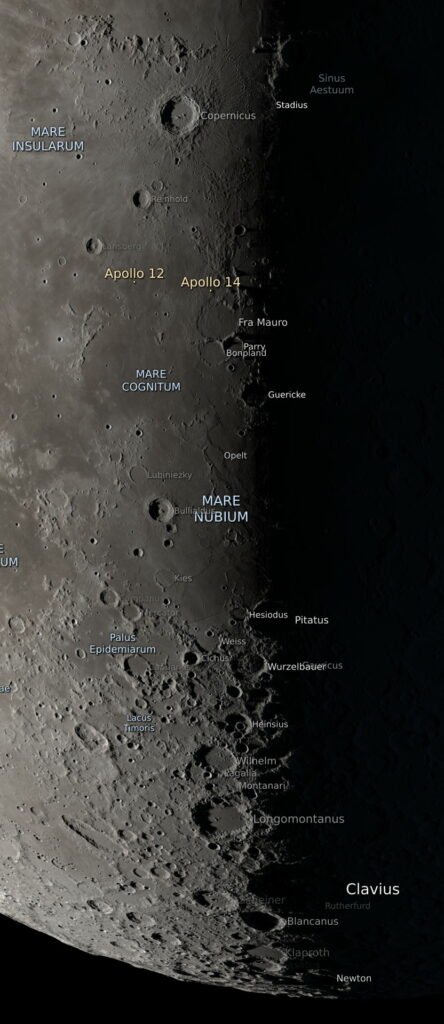 Annotated close-up of the Moon on Sep. 11th. Visualizations by Ernie Wright / NASA’s Scientific Visualization Studio.
Annotated close-up of the Moon on Sep. 11th. Visualizations by Ernie Wright / NASA’s Scientific Visualization Studio.Moon News
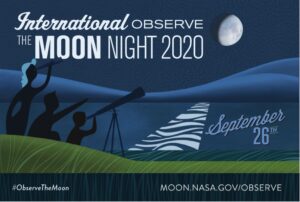 International Observe the Moon Night – Sept. 26th
International Observe the Moon Night – Sept. 26th
A time to come together with fellow Moon enthusiasts and curious people worldwide. Everyone on Earth is invited to learn about lunar science and exploration, take part in celestial observations, and honor cultural and personal connections to the Moon. Note that we encourage you to interpret “observe” broadly.

The Sun has been spot-free for 18 days; the northern coronal hole remains monstrous, the coronal hole at the south pole as a couple tendrils reaching towards the equator.
The Sun seen in 193 angstroms (extreme ultraviolet) September 7, 2020:
More long-lasting large prominences over the last several days have made for great astrophoto targets!
The Sun seen in 304 angstroms (extreme ultraviolet) September 7, 2020:
You can view the Sun in near real-time, in multiple frequencies here: SDO-The Sun Now.
You can create your own time-lapse movies of the Sun here: AIA/HMI Browse Data.
You can browse all the SDO images of the Sun from 2010 to the present here: Browse SDO archive.
Solar Activity on Facebook – Run by Volunteer NASA/JPL Solar System Ambassador Pamela Shivak
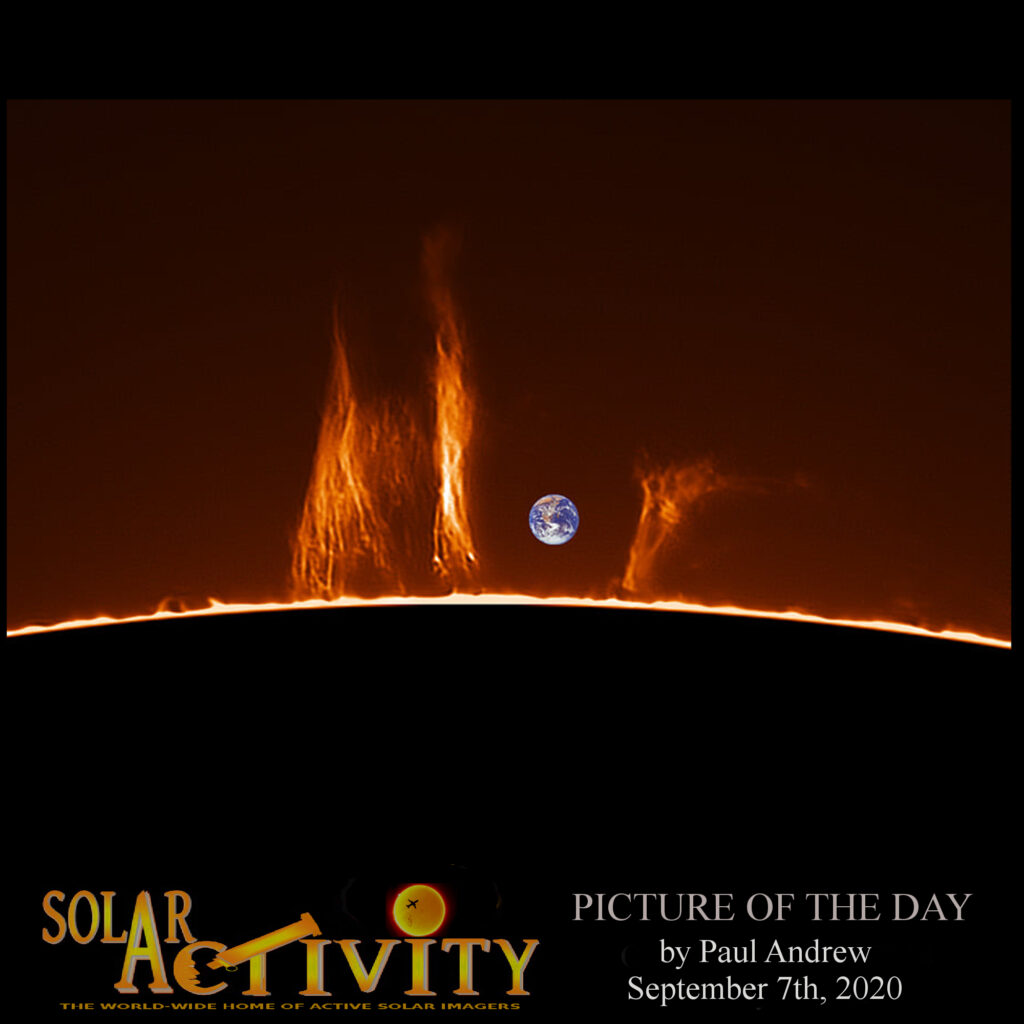 SOLARACTIVITY PICTURE OF THE DAY for Monday, September 7th, 2020 goes out to Paul Andrew for this amazing prominence capture.
SOLARACTIVITY PICTURE OF THE DAY for Monday, September 7th, 2020 goes out to Paul Andrew for this amazing prominence capture.Paul commented: “A nice prominence captured on 6th September from Kent, UK, with my Lunt LS152, ZWO ASI290MM camera, and a Tele Vue 2.5x Powermate.”
Solar Corona
Solar wind speed is 316.0 km/sec (↓), with a density of 6.5 protons/cm3 (↓) at 1415 UT.
Near real-time animation of the corona and solar wind from the Solar & Heliospheric Observatory (SOHO):
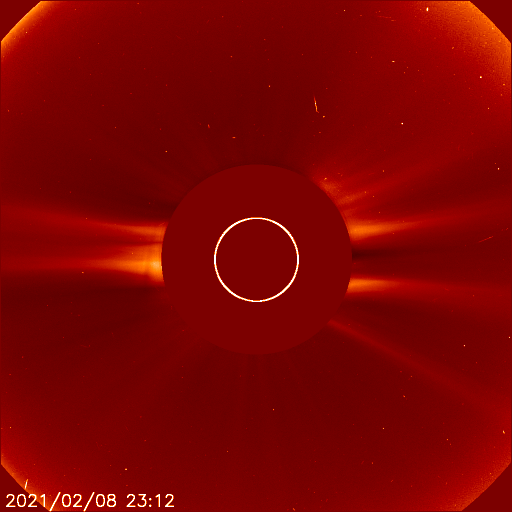 Animated LASCO C2 Coronograph showing the solar corona above the Sun’s limb (the white circle). Credit: NASA/JPL-Caltech-SOHO
Animated LASCO C2 Coronograph showing the solar corona above the Sun’s limb (the white circle). Credit: NASA/JPL-Caltech-SOHOSun News

Potentially hazardous asteroids: 2037 (last updated June 2, 2020)
Total Minor Planets discovered: 994,412 (+29) – closing in on 1 million!
Upcoming Earth-asteroid encounters:
| Asteroid |
Date(UT)
|
Miss Distance
|
Velocity (km/s)
|
Diameter (m)
|
| 2020 RC |
2020-Sep-06
|
12.9 LD
|
16.6
|
150
|
| 2020 PT4 |
2020-Sep-08
|
4.9 LD
|
12.6
|
36
|
| 2020 RJ |
2020-Sep-08
|
3.3 LD
|
9.3
|
25
|
| 2020 RM |
2020-Sep-11
|
2.7 LD
|
6.5
|
14
|
| 2012 RM15 |
2020-Sep-12
|
14.9 LD
|
9.8
|
45
|
| 2017 US |
2020-Sep-13
|
17.3 LD
|
5.9
|
21
|
| 2020 QL2 |
2020-Sep-14
|
17.9 LD
|
10.6
|
71
|
| 2014 QJ33 |
2020-Sep-17
|
6.7 LD
|
8.7
|
65
|
| 2017 SL16 |
2020-Sep-20
|
8.9 LD
|
6.4
|
25
|
| 2020 RO |
2020-Sep-25
|
15.3 LD
|
11.8
|
77
|
| 2001 GP2 |
2020-Oct-01
|
6.1 LD
|
2.2
|
15
|
| 2010 UC |
2020-Oct-04
|
14.6 LD
|
3.2
|
12
|
| 2019 SB6 |
2020-Oct-07
|
11.9 LD
|
7.6
|
16
|
| 2018 GD2 |
2020-Oct-13
|
16.4 LD
|
6.7
|
5
|
| 2017 UH5 |
2020-Oct-20
|
8.9 LD
|
5.9
|
18
|
| 2018 VG |
2020-Oct-21
|
15.1 LD
|
6.7
|
12
|
| 2017 TK6 |
2020-Oct-24
|
17.3 LD
|
12.4
|
41
|
| 2008 GM2 |
2020-Oct-25
|
17.7 LD
|
3.6
|
8
|
| 2020 QD5 |
2020-Oct-26
|
10.1 LD
|
8.6
|
80
|
| 2020 OK5 |
2020-Oct-29
|
6.4 LD
|
1.3
|
27
|
| 2018 VP1 |
2020-Nov-02
|
1.1 LD
|
9.7
|
2
|
| 2020 HF4 |
2020-Nov-03
|
16.2 LD
|
2.9
|
11
|
| 2010 JL88 |
2020-Nov-05
|
10.5 LD
|
15.7
|
16
|
Notes: LD means “Lunar Distance.” 1 LD = 384,401 km, the distance between Earth and the Moon. Red highlighted entries are asteroids that either pass very close, or very large with high relative velocities to the Earth. Table from SpaceWeather.com
Asteroid News:
 On September 7, 2020, the NASA All Sky Fireball Network reported 25 fireballs.
On September 7, 2020, the NASA All Sky Fireball Network reported 25 fireballs.
(19 sporadics, 6 September epsilon Perseids)
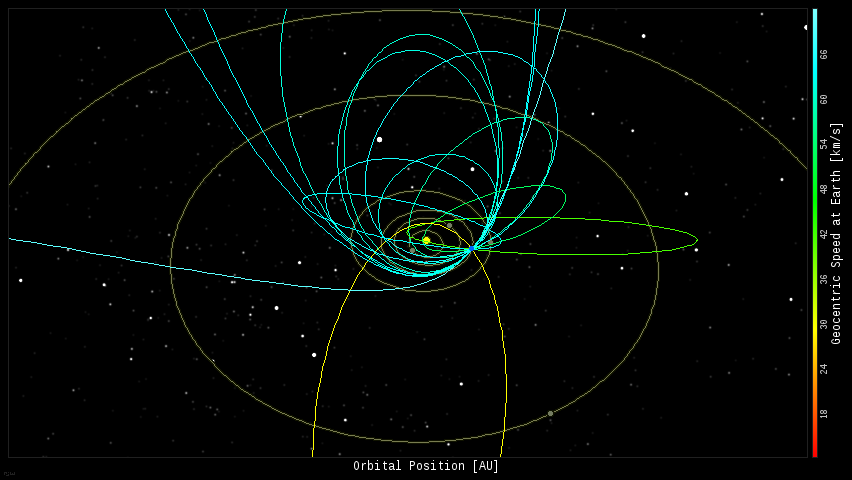 In this diagram of the inner solar system, all of the fireball orbits intersect at a single point–Earth. The orbits are color-coded by velocity, from slow (red) to fast (blue). Credit: SpaceWeather.com
In this diagram of the inner solar system, all of the fireball orbits intersect at a single point–Earth. The orbits are color-coded by velocity, from slow (red) to fast (blue). Credit: SpaceWeather.comFireball News:
 Position of the planets and a couple spacecraft in the inner solar system.
Position of the planets and a couple spacecraft in the inner solar system.
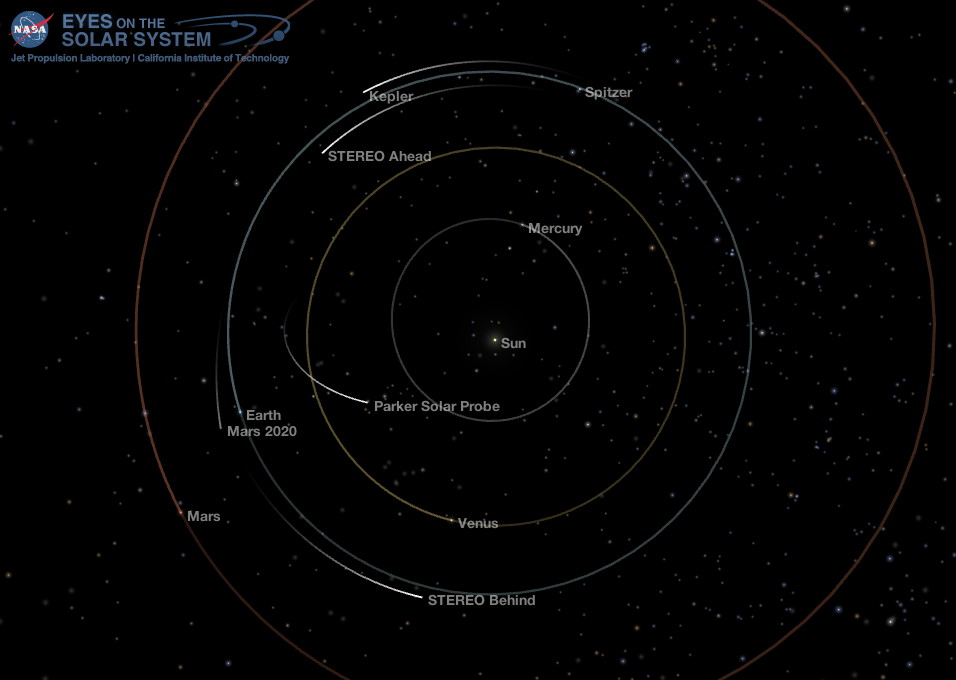 Position of the planets and a couple spacecraft in the inner solar system, 2020-09-08. Credit: NASA Eyes on the Solar System / Bob Trembley.
Position of the planets and a couple spacecraft in the inner solar system, 2020-09-08. Credit: NASA Eyes on the Solar System / Bob Trembley.Position of the planets in the middle solar system:
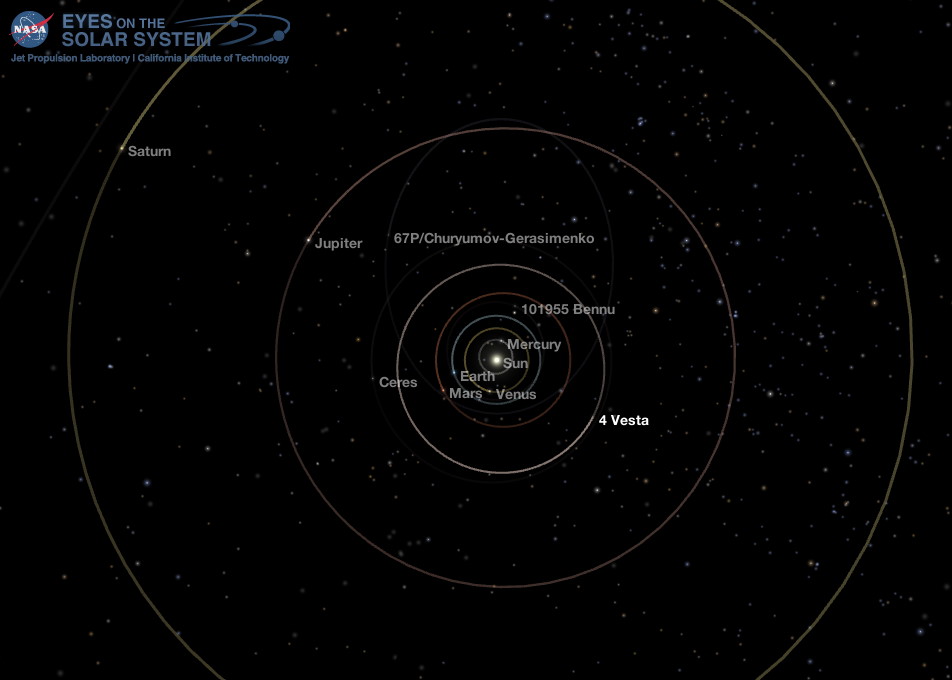 Position of the planets in the middle solar system, 2020-09-08 – the orbit of asteroid Vesta is highlighted. Credit: NASA Eyes on the Solar System / Bob Trembley.
Position of the planets in the middle solar system, 2020-09-08 – the orbit of asteroid Vesta is highlighted. Credit: NASA Eyes on the Solar System / Bob Trembley.Position of the planets, some dwarf planets and some transneptunian objects in the outer solar system – the orbit of comet Siding Spring is highlighted:
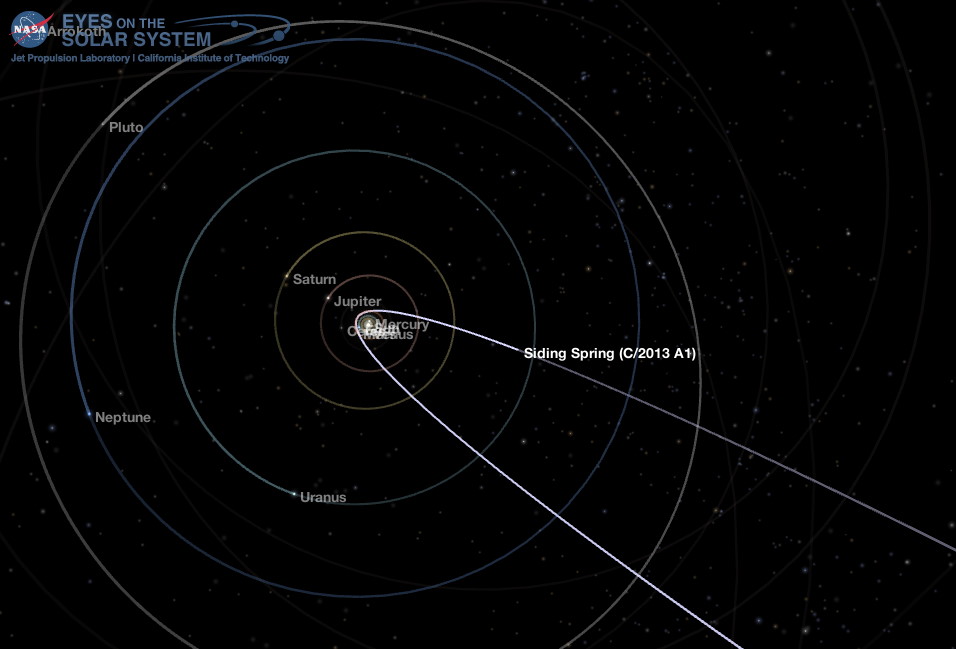 Position of the planets and some transneptunian objects in the outer solar system, 2020-09-08 – the orbit of comet Siding Spring is highlighted. Credit: NASA Eyes on the Solar System / Bob Trembley.
Position of the planets and some transneptunian objects in the outer solar system, 2020-09-08 – the orbit of comet Siding Spring is highlighted. Credit: NASA Eyes on the Solar System / Bob Trembley.Extreme Zoom-out showing Siding Spring’s Orbit:
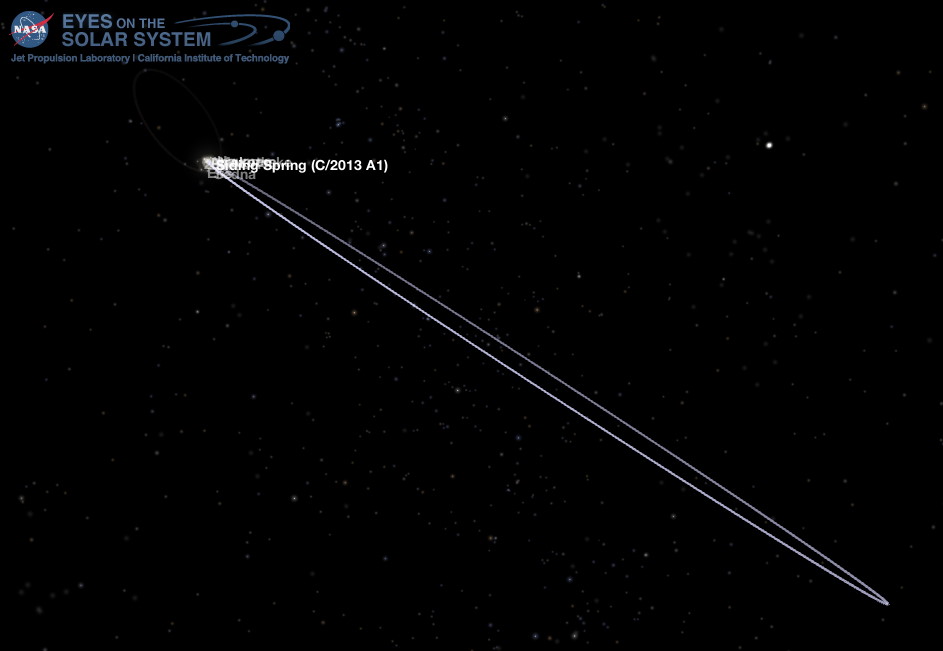 The full orbit of comet Siding Spring; you can just see the orbit of Sedna stretching towards the logo. Credit: NASA Eyes on the Solar System / Bob Trembley.
The full orbit of comet Siding Spring; you can just see the orbit of Sedna stretching towards the logo. Credit: NASA Eyes on the Solar System / Bob Trembley.

NASA’s OSIRIS-REx Asteroid Sample Return Mission
International Space Station
NASA Perseverance Mars Rover
Climate

ex·o·plan·et /ˈeksōˌplanət/, noun: a planet orbiting a star other than the Sun.
Data from the NASA Exoplanet Archive
* Confirmed Planets Discovered by TESS refers to the number planets that have been published in the refereed astronomical literature.
* TESS Project Candidates refers to the total number of transit-like events that appear to be astrophysical in origin, including false positives as identified by the TESS Project.
* TESS Project Candidates Yet To Be Confirmed refers to the number of TESS Project Candidates that have not yet been dispositioned as a Confirmed Planet or False Positive.

Northern Ireland’s Davagh Forest Park Designated as a Dark Sky Park
Hubble: Beautiful Universe
Tour of the Local Stellar Neighborhood
Continuing with my visual tour of nearby stars and their systems, we travel to the Gliese 687 system, about 15 light years distant.
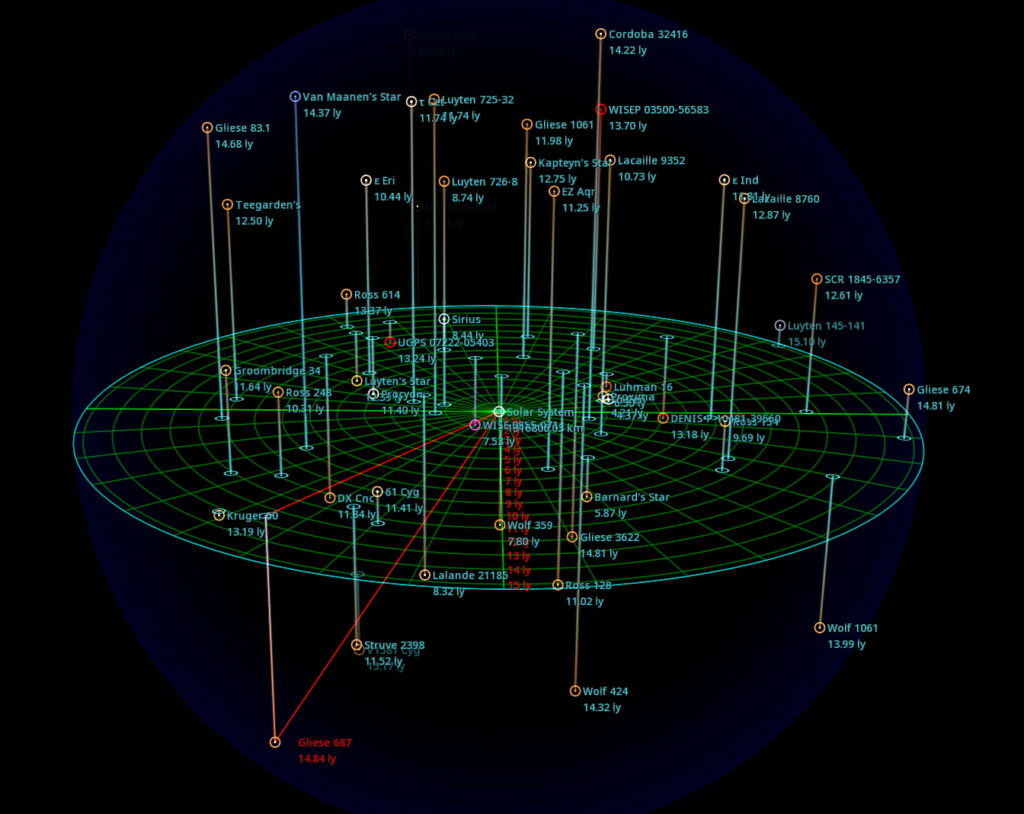 Gliese 687 is about 15 light years from Sol; the plane (green) is aligned with the orientation of the plane of the Milky Way galaxy. Credit: SpaceEngine / Bob Trembley.
Gliese 687 is about 15 light years from Sol; the plane (green) is aligned with the orientation of the plane of the Milky Way galaxy. Credit: SpaceEngine / Bob Trembley.Gliese 687
Gliese 687, or GJ 687 (Gliese–Jahreiß 687) is a red dwarf in the constellation Draco. This is one of the closest stars to the Sun and lies at an approximate distance of less than 15 light years. Even though it is close by, it has a magnitude of about 9, so it can only be seen through a moderately sized telescope. Gliese 687 has a high proper motion, advancing 1.304 arcseconds per year across the sky. It has a net relative velocity of about 39 km/s. It is known to have a Neptune-mass planet. Old books and articles refer to it as Argelander Oeltzen 17415.
Gliese 687 has about 40% of the Sun’s mass and nearly 50% of the Sun’s radius. Compared to the Sun, it has a slightly higher proportion of elements with higher atomic numbers than helium. It appears to have a rotation of 60 days and to be somewhat chromospherically active.
It displays no excess of infrared radiation that would indicate orbiting dust.
In 2014, it was discovered to have a planet, Gliese 687 b, with a minimum mass of 18.394 Earth masses (which makes it comparable to Neptune), an orbital period of 38.14 days, a low orbital eccentricity and inside the habitable zone. Another Neptune mass planet candidate was discovered in 2020, in a further out and much colder orbit. – Wikipedia
Gliese 687 System Diagram
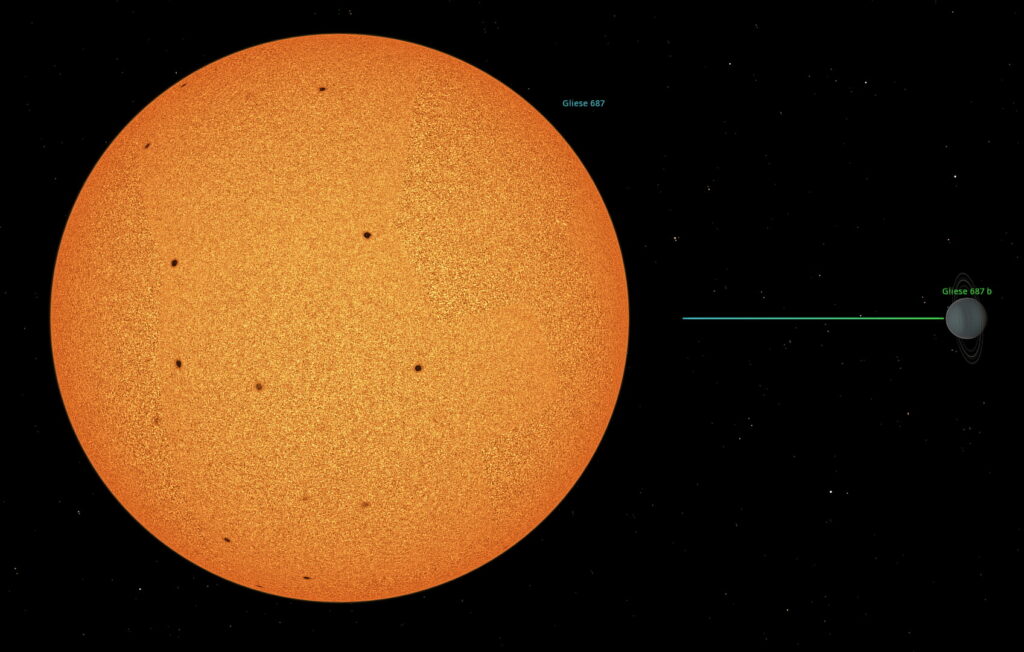 Gliese 687 System Diagram. NOTE: Exoplanet Gliese 687 c has not been added into SpaceEngine yet. Credit: SpaceEngine / Bob Trembley.
Gliese 687 System Diagram. NOTE: Exoplanet Gliese 687 c has not been added into SpaceEngine yet. Credit: SpaceEngine / Bob Trembley.Gliese 687 Exoplanet Orbital Diagram
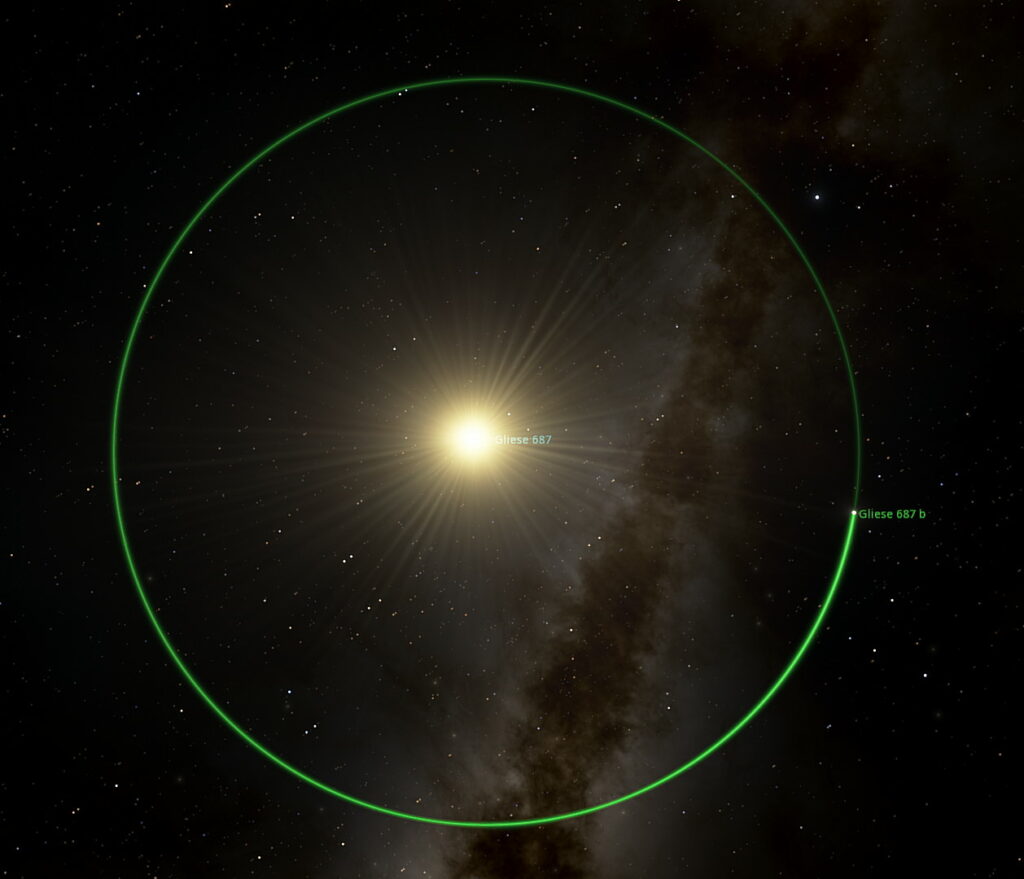 Gliese 687 Orbital Diagram. NOTE: Exoplanet Gliese 687 c has not been added into SpaceEngine yet. Credit: SpaceEngine / Bob Trembley.
Gliese 687 Orbital Diagram. NOTE: Exoplanet Gliese 687 c has not been added into SpaceEngine yet. Credit: SpaceEngine / Bob Trembley.Artist’s Renderings of Exoplanet Gliese 687 b
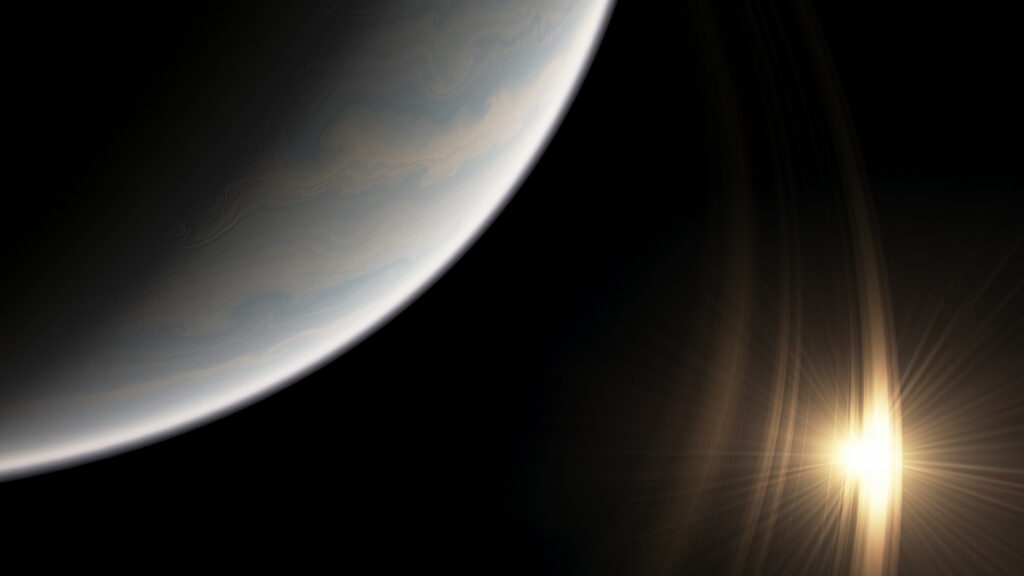 Artistic rendering of red dwarf Gliese 687 seen through the hypothetical rings of real exoplanet Gliese 687 b. Credit: SpaceEngine / Bob Trembley.
Artistic rendering of red dwarf Gliese 687 seen through the hypothetical rings of real exoplanet Gliese 687 b. Credit: SpaceEngine / Bob Trembley.Stay safe, be well, and look up!
Apps used for this post:
NASA Eyes on the Solar System: an immersive 3D solar system and space mission simulator – free for the PC /MAC. I maintain the unofficial NASA Eyes Facebook page.
Universe Sandbox: a space simulator that merges real-time gravity, climate, collision, and material interactions to reveal the beauty of our universe and the fragility of our planet. Includes VR support.
SpaceEngine: a free 3D Universe Simulator for Windows. Steam version with VR support available.
Stellarium: a free open source planetarium app for PC/MAC/Linux. It’s a great tool for planning observing sessions. A web-based version of Stellarium is also available.
Section header image credits:
The Sky – Stellarium / Bob Trembley
Observing Target – Turn Left at Orion / M. Skirvin
The Moon – NASA/JPL-Caltech
The Sun – NASA/JPL-Caltech
Asteroids – NASA/JPL-Caltech
Fireballs – Credited to YouTube
Comets – Comet P/Halley, March 8, 1986, W. Liller
The Solar System – NASA Eyes on the Solar System / Bob Trembley
Spacecraft News – NASA Eyes on the Solar System / Bob Trembley
Exoplanets – Space Engine / Bob Trembley
Light Pollution – NASA’s Black Marble
The Universe – Universe Today

